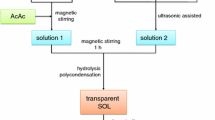Abstract
Zirconia containing 10 mol% scandia and x mol% dysprosia (0 ≤ x ≤ 1.5) gels was synthesized by simultaneous precipitation at room temperature. The aim of this work is to verify the effect of dysprosium on the cubic phase stabilization of the zirconia–scandia solid electrolyte. The gel was characterized by thermogravimetry, differential scanning calorimetry, and differential thermal analyses. The thermally treated powders were analyzed by Fourier transform infrared spectroscopy, thermal analyses, and X-ray diffraction techniques. For comparison purpose, a commercial zirconia–10 mol% scandia powder was subjected to some characterization techniques. The infrared spectrum shows characteristic absorption bands due to residual material from the synthesis on the surface of the powder particles. Nanostructured powders were obtained after thermal treatments at 500 °C for 2 h. Infrared spectroscopy and X-ray diffraction results evidence the stabilization of the cubic phase in zirconia–scandia containing dysprosium. The thermal stability of the cubic phase during thermal cycling was ascertained by thermal analysis.








Similar content being viewed by others
References
Subbarao EC. Solid electrolytes and their applications. New York: Plenum Press; 1980.
Minh NQ. Ceramic fuel cells. J Am Ceram Soc. 1993;76:563–88.
Fergus JW. Electrolytes for solid oxide fuel cells. J Power Sourc. 2006;162:30–40.
Nomura K, Mizutani Y, Kawai M, Nakamura Y, Yamamoto O. Aging and Raman scattering study of scandia and yttria doped zirconia. Solid State Ion. 2000;132:235–9.
Badwal SPS, Ciacchi FT, Milosevic D. Scandia–zirconia electrolytes for intermediate temperature solid oxide fuel cell operation. Solid State Ion. 2000;136(137):91–9.
Wang Z, Cheng M, Bi Z, Dong Y, Zhang H, Zhang J, Feng Z, Li C. Structure and impedance of ZrO2 doped with Sc2O3 and CeO2. Mater Lett. 2005;59:2579–82.
Ishii T, Iwata T, Tajima Y, Yamaji A. Structural phase transition and ion conductivity in 0.88ZrO2–0.12Sc2O3. Solid State Ion. 1992;57:153–7.
Tao J, Hao Y, Wang J. The research of crystal structure and electrical properties of a new electrolyte material: scandia and holmia stabilized zirconia. J Ceram Soc Jpn. 2013;121:317–25.
Omar S, Najib WB, Chen W, Bonanos N. Electrical conductivity of 10 mol% Sc2O3-1 mol% M2O3–ZrO2 ceramics. J Am Ceram Soc. 2012;95:1965–72.
Yamamoto O, Arati Y, Takeda Y, Imanishi N, Mizutani Y, Kawai M, Nakamura Y. Electrical conductivity of stabilized zirconia with ytterbia and scandia. Solid State Ion. 1995;79:137–42.
Politova TI, Irvine JTS. Investigation of scandia–yttria–zirconia system as an electrolyte material for intermediate temperature fuel cells-influence of yttria content in system (Y2O3) x (Sc2O3)(11−x)(ZrO2)89. Solid State Ion. 2004;168:153–65.
Fujimori H, Yashima M, Kakihana M, Yoshimura M. β-cubic phase transition of scandia-doped zirconia solid solution: calorimetry, X-ray diffraction, and Raman scattering. J Appl Phys. 2002;91:6493–8.
Shayachmetov U, Dranca I. Use of methods of thermal analysis in studying ceramic materials on the basis of Al2O3, ZrO2, Si3N4, SiC and inorganic binder. J Therm Anal Calorim. 2001;64:1153–61.
Pastor M, Maiti S, Pandey A, Biswas K, Manna I. Effect of dysprosia doping on structural and electrical property of stabilized zirconia for intermediate-temperature SOFCs. Mater Chem Phys. 2011;125:202–9.
Kalizewski MS, Heuer AH. Alcohol interaction with zirconia powders. J Am Ceram Soc. 1990;73:1504–9.
Lange FF. Powder processing science and technology for increased reliability. J Am Ceram Soc. 1989;72:3–15.
Warren BE. X-ray diffraction. New York: Dover; 1990.
George A, Seena PT. Thermal studies on zirconium hydroxide gel formed by aqueous gelation. J Thermal Anal Calorim. 2012;110:1037–41.
Tadokoro SK, Muccillo ENS. Physical characteristics and sintering behavior of ultrafine zirconia–ceria powders. J Eur Ceram Soc. 2002;22:1723–8.
Ávila DM, Muccillo ENS. Influence of some variables of the precipitation process on the structural characteristics of fine zirconia powders. Thermochim Acta. 1995;256:391–8.
McDevitt NT, Baun WL. Infrared absorption spectroscopy in zirconia research. J Am Ceram Soc. 1964;47:622–4.
Phillippi CM, Mazdiyasni KS. Infrared and Raman spectra of zirconia polymorphs. J Am Ceram Soc. 1971;54:254–8.
Acknowledgements
The authors gratefully acknowledge FAPESP, CNPq, and CNEN for financial supports, CTR/IPEN and Polytechnique School of the University of S. Paulo for some thermal analysis and FTIR measurements.
Author information
Authors and Affiliations
Corresponding author
Rights and permissions
About this article
Cite this article
Grosso, R.L., Matos, J.R. & Muccillo, E.N.S. Thermal and spectroscopic characterization of nanostructured zirconia–scandia–dysprosia. J Therm Anal Calorim 117, 567–572 (2014). https://doi.org/10.1007/s10973-014-3766-7
Received:
Accepted:
Published:
Issue Date:
DOI: https://doi.org/10.1007/s10973-014-3766-7




